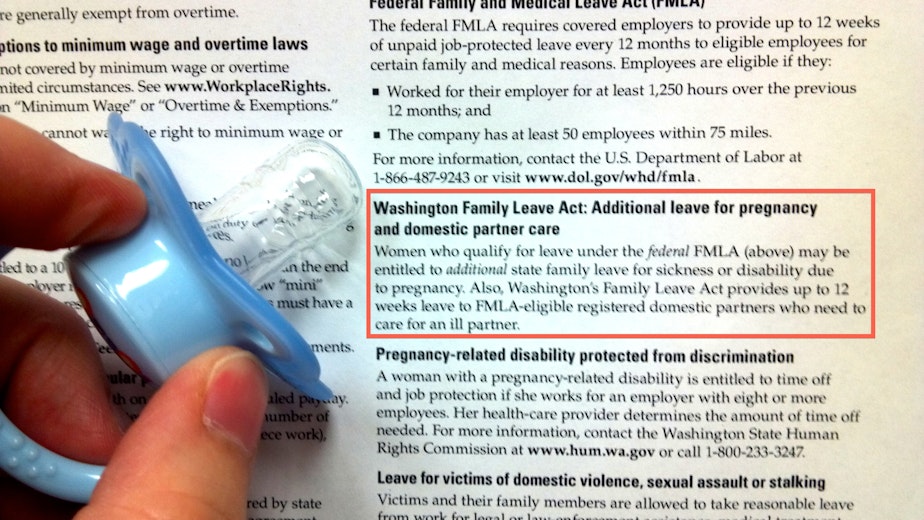Lesser-Known Washington Law Doubles Maternity Leave To 24 Weeks

A long-standing state law in Washington gives working mothers up to 24 weeks off when they have babies. If you didn’t know, you must not have read the poster in your break room at work. You know, the one everyone is always leaning over and squinting at to find out what their rights are.
Before Gay Marriage And Pot
“This isn’t one of the laws that’s well-known,” said Elaine Fischer of the Washington Department of Labor and Industries, which enforces the state Family Leave Act. The state FLA predates the federal Family and Medical Leave Act, which turned 20 this week.
The FLA became state law in 1989. Fischer says the federal FMLA largely superseded state law when it passed in 1993. But the state FLA “kicks in where the federal law doesn’t,” said Fischer. The state law can give military service members and their caregivers more time off after FMLA leave is exhausted or no longer in use. The state FLA protects registered domestic partners and same-sex spouses where federal law does not. It can also grant maternity leave for up to twice as long as federal law allows. Under both laws, birth mothers are entitled to 12 weeks off plus the time a doctor recommends, up to a total of 24 weeks.
Read The Tiny, Tiny Print
Sponsored
The state advertises the FLA on posters like the one pictured. Employers are required to display them. You may have seen a state poster taped to a break room wall or thumbtacked to a bulletin board in a mail room. They are designed for 11-by-17 inch paper. When they are printed on 8½-by-11 inch paper, the paragraph in the second column about the FLA and pregnancy is ⅞ inch long.
“We hope that people, when they are planning to have a baby or if they are pregnant, will try to find out what their rights are,” said Fischer. Labor and Industries offers a thorough FLA Q-and-A on its website, and the Washington State Human Rights Commission has written guidance about how the state and federal family leave laws intersect. Both documents are top results of the right Google search, if one knows to look. But a state law from 1988 requires employers to inform workers of the FLA only through a poster — so it may be absent from your employee handbook or website.
In a three-year, highly unscientific survey of dozens of working women, this reporter found two who knew about the state FLA: a human resources professional and an attorney who specializes in employment law. Said Fischer, “There are cases where people are very delighted and surprised to find out they’re entitled to this additional leave.”
It’s Not For Everyone
Other women are disappointed to learn they do not qualify for FLA protection. The state FLA, like federal law, does not guarantee months of parental leave for half-time workers, new hires, or employees of small businesses (although other laws offer some protections to those workers). The state FLA also does not require employers to pay employees during leave. Some workers do not avail themselves of their full FLA and FMLA rights because they find they cannot afford to.
Sponsored
Fathers, adoptive parents and other caregivers do not see added benefit from the intersection of the two laws — not beyond the 12 weeks guaranteed by federal law. Neither do employees who have medical issues unrelated to a birth (except when those issues occur within a year of FMLA-protected events related to military deployment). But in its current form, the FLA would provide protection similar to FMLA if the federal law were repealed.
A worker whose FLA rights have been violated may file a complaint with the state.

